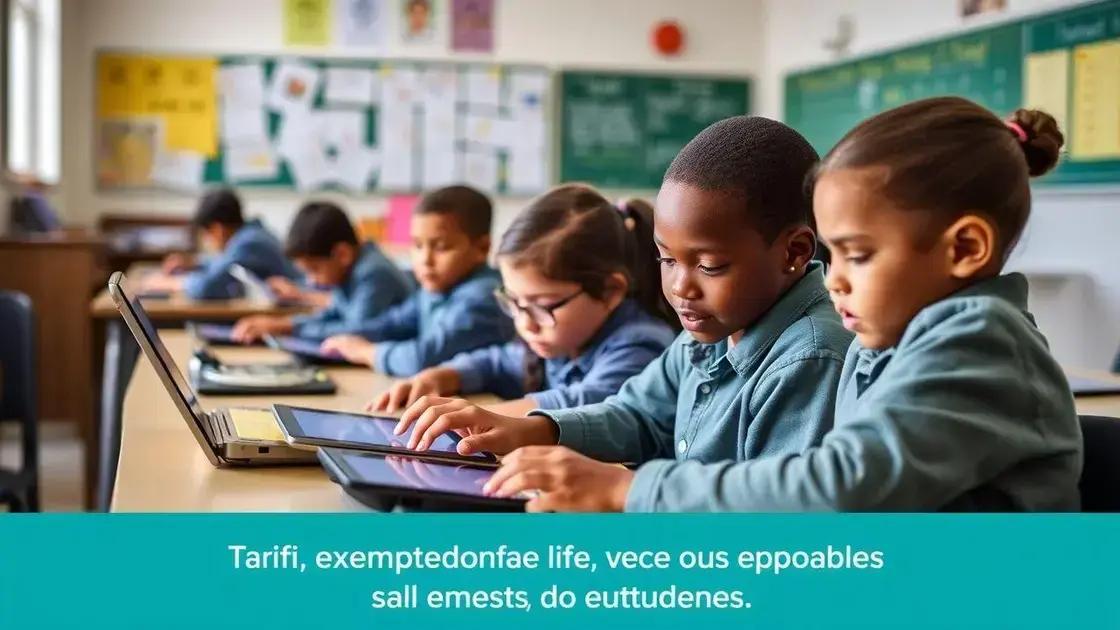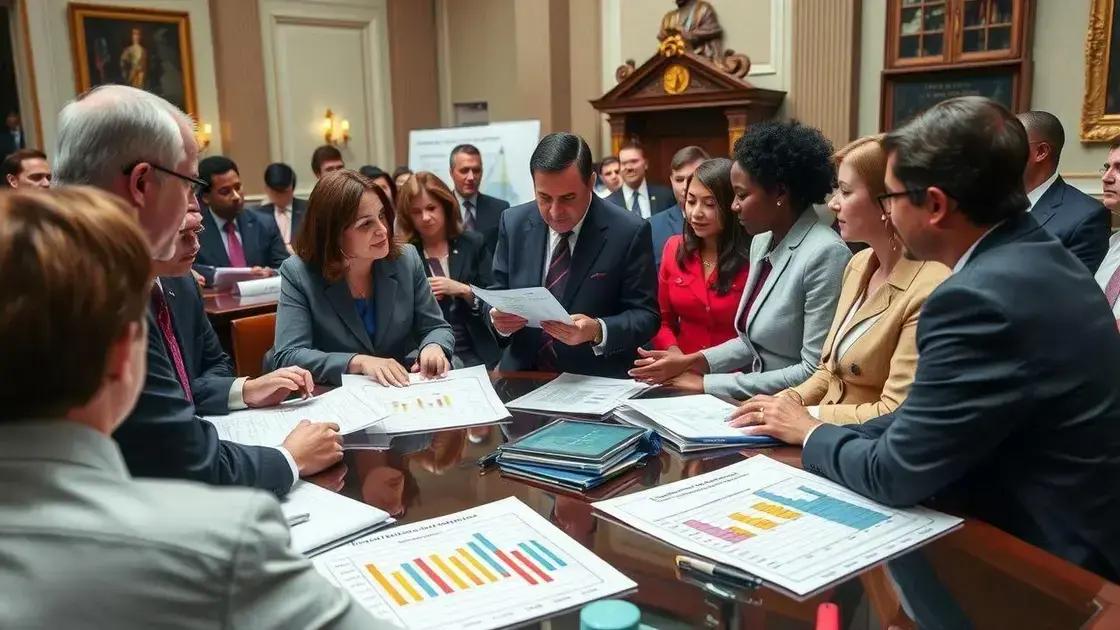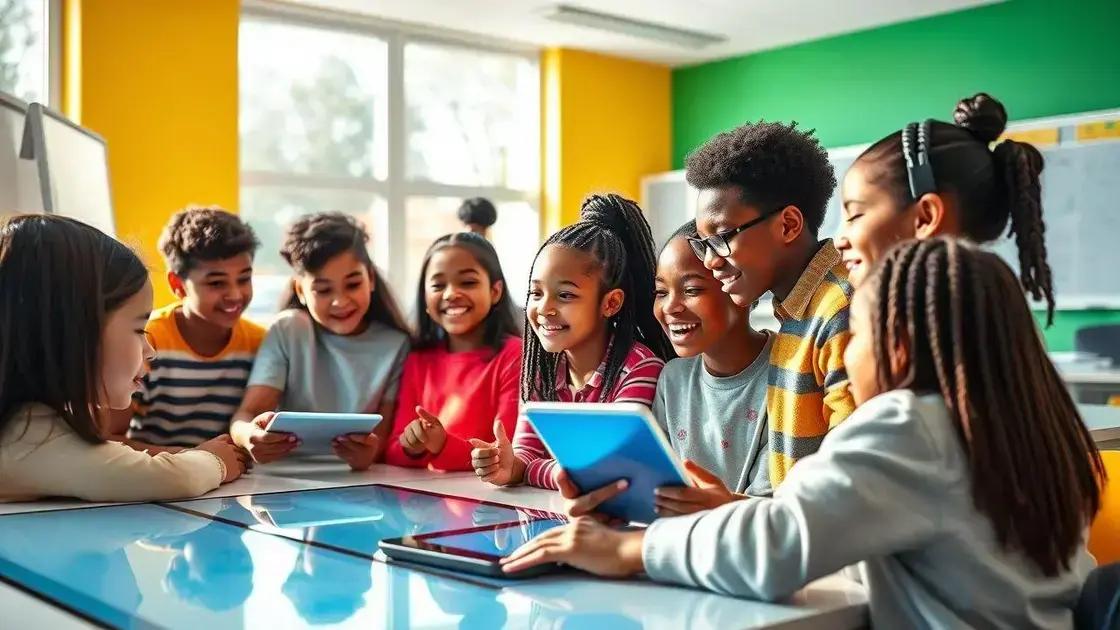Teacher workforce challenges: an analysis of tariff exemptions

The teacher workforce faces significant challenges due to technology access issues, evolving roles, and the need for continuous professional development, all of which impact educational effectiveness in modern classrooms.
In today’s discussion on teacher workforce challenges, we delve into significant issues impacting educators and institutions. With shifts in policy, especially regarding technology accessibility, it’s essential to understand how these changes affect you and your community.
Understanding the teacher workforce landscape
Understanding the teacher workforce landscape is vital for grasping the current challenges in education. The dynamics here involve factors like recruitment, retention, and overall job satisfaction among educators. It is essential to recognize how these aspects contribute to the quality of education that students receive.
Key Factors Influencing the Teacher Workforce
Several elements play a significant role in shaping the teacher workforce. Among them, we can highlight the following:
- Professional development opportunities for teachers
- Work-life balance and job satisfaction
- Compensation and benefits
- Support systems within schools
These factors can significantly impact a teacher’s decision to stay in or leave the profession. When teachers feel supported and valued, they are more likely to remain dedicated to their roles.
Another important aspect is the demographic changes in the teacher workforce. As schools become more diverse, understanding the cultural backgrounds of teachers and students can foster a more inclusive environment that benefits everyone.
Challenges in Recruitment and Retention
The challenges of recruitment and retention of teachers continue to grow. Many schools struggle to find qualified candidates to fill teaching positions. This shortage leads to increased workloads for current teachers, which can affect their performance and teaching quality.
- Resource availability in schools
- Policy changes impacting hiring procedures
- The role of technology in teaching
As these challenges persist, it’s essential for school districts and decision-makers to collaborate to find viable solutions to enhance the teacher workforce landscape.
Impact of tariffs on educational technology
The impact of tariffs on educational technology is significant and multifaceted. These tariffs can lead to increased costs for schools that rely on technology to enhance learning. When the price of educational tools rises, budgets become tighter, forcing schools to make tough choices about resources.
How Tariffs Affect Funding
Tariffs directly affect funding for educational institutions by increasing the overall cost of technology purchases. When expenses go up, schools may struggle to afford necessary tools. This situation can lead to:
- Reduced technology purchases
- Cutbacks on new software or hardware updates
- Limited access to innovative learning solutions
- Increased strain on educators to adapt without proper resources
As a result, teachers may find themselves without the tools they need to engage students effectively.
Moreover, tariffs on imported educational technology can slow the rate of technological advancement in classrooms. Without access to the latest tools and platforms, students may fall behind in their digital skills, impacting their future opportunities.
The Ripple Effect on Students and Teachers
The ramifications of these tariffs can extend beyond financial burdens. Students who lack access to current technology may find it harder to connect with lessons. They miss out on hands-on learning experiences that are crucial in today’s tech-driven world. This gap in education can create disparities among students from different backgrounds.
- Teachers facing tech limitations may feel frustrated
- Students may struggle with outdated information
- Overall learning outcomes can decline
By understanding the impact of tariffs on educational technology, we highlight the need for policies that consider the importance of technology in learning environments. As discussions about tariffs continue, it’s vital to prioritize the needs of educators and students alike.
How tariff exemptions benefit schools

Understanding how tariff exemptions benefit schools is crucial for educators and administrators. These exemptions can lead to significant savings on educational technology purchases. When schools save money, they can allocate these funds to enhance student learning experiences and improve resources.
Financial Relief for Educational Institutions
One of the primary benefits of tariff exemptions is the financial relief they provide. Schools can purchase the latest technology without the added burden of high tariffs. This results in:
- Lower prices for essential technological tools
- Increased budget flexibility for other educational needs
- Enhanced access to educational resources for students
- Opportunities for schools to innovate
With more funds available, schools can invest in new science labs, library upgrades, and extracurricular programs that enrich the overall educational experience.
Moreover, lower costs on tech devices mean that teachers can use modern tools to engage students effectively. This approach helps build a tech-savvy generation that is better prepared for future challenges.
Improved Access to Cutting-Edge Tools
Beyond savings, tariff exemptions allow schools to gain access to advanced educational tools that may have otherwise been financially out of reach. These tools can include:
- Interactive whiteboards
- Virtual reality equipment
- High-quality laptops and tablets
- Innovative software programs
As schools adopt these technologies, they create more dynamic classrooms that adapt to various learning styles. For instance, students who benefit from hands-on learning can thrive with devices that support interactive lessons.
Challenges teachers face with technology access
Teachers today encounter several challenges regarding technology access in their classrooms. While technology can enhance learning, not all educators have equal access to the necessary tools. This discrepancy leads to frustration and disparity in the educational experience for students.
Limitations on Resources
One major challenge is the limitation of resources available for teachers. Many schools operate on tight budgets, which can affect technology purchases. When funds run low, teachers may not have:
- Access to current computers and tablets
- High-speed internet connectivity
- Educational software tools
- Professional development training for tech integration
These limitations can hinder effective teaching and learning. Educators must often find creative solutions to work around these challenges.
Furthermore, some teachers may feel overwhelmed by the rapid pace of technological change. Keeping up with new tools and applications can require significant time and effort. Even when schools provide access, the fear of not being proficient can prevent teachers from utilizing technology fully.
The Digital Divide
The digital divide significantly impacts how teachers utilize technology. In various regions, access to technology can vary widely. Some teachers have all the tools needed, while others may lack basic equipment. This divide creates inequalities that affect student learning outcomes.
- Students from low-income families often cannot access the same technology at home
- Both teachers and students face challenges in completing assignments
- Teachers may have to adapt lessons to accommodate varying levels of access
By recognizing these challenges, it becomes clear that addressing technology access is essential for creating equitable educational environments.
The future of the teacher workforce amid changes
The future of the teacher workforce is evolving due to various changes in society and technology. Understanding these shifts is crucial for preparing educators for what is to come. As we look ahead, we can expect challenges and opportunities to reshape teaching roles.
Adapting to Technological Advances
One major aspect of the future for teachers involves adapting to rapid technological advances. Educators will need to integrate new tools and methods into their teaching practices. Some potential areas of focus include:
- Online and blended learning environments
- Use of artificial intelligence in education
- Incorporating gamification into lesson plans
- Enhancing digital literacy among students
These advancements can empower teachers to create more engaging and interactive lessons. However, educators must receive adequate training to effectively use these technologies.
Furthermore, as classrooms become more diverse due to globalization, teachers will need to adopt culturally responsive teaching strategies. Understanding different backgrounds and learning styles becomes key to fostering an inclusive learning environment.
Changing Roles and Expectations
As the education landscape shifts, the roles and expectations for teachers are also changing. With the rise of technology, traditional methods of teaching may no longer suffice. Teachers are increasingly expected to:
- Facilitate personalized learning experiences
- Engage students in critical thinking and problem-solving
- Act as mentors and guides
- Collaborate with parents and communities
In this new environment, teachers play a more facilitatory role, guiding students rather than simply delivering content. As a result, professional development will be vital to ensure teachers are equipped for these new responsibilities.
Overall, the future of the teacher workforce will undoubtedly be shaped by these changes. By embracing technological advancements and adapting to new roles, teachers can help forge a path for future generations.
The future of the teacher workforce is bright yet challenging. With technology advancing rapidly, teachers must adapt to new tools and teaching methods. Embracing these changes will help educators foster a more engaging and inclusive learning environment. By overcoming the challenges of technology access and evolving roles, teachers can significantly impact their students’ educational experiences. Continuous professional development and support will be essential in navigating this transformation, ensuring that teachers are well-equipped for the future. Together, we can work towards a better educational landscape that benefits both teachers and students alike.
FAQ – Frequently Asked Questions about the Teacher Workforce and Technology
What challenges do teachers face with technology access?
Teachers often struggle with limited resources, outdated equipment, and insufficient training on new technologies.
How can tariff exemptions benefit schools?
Tariff exemptions reduce costs for educational technology, allowing schools to purchase necessary tools and resources more easily.
What is the importance of continuous professional development for teachers?
Continuous professional development helps teachers stay updated with new teaching methods and technologies, improving their effectiveness in the classroom.
How is the role of teachers changing with advancements in technology?
Teachers are transitioning from traditional lecturing to facilitating personalized learning experiences and mentoring students.






